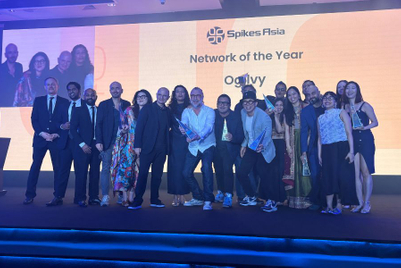
Spikes Asia celebrates creative excellence from Asia-Pacific, and for Japanese independent PR agency Honda Office Tokyo and their client Ajinomoto, this was their opportunity to make their mark.
Rika Komakine from Ajinomoto Frozen Foods Co., Inc. and Tetsuya Honda, CEO and PR strategist at Honda Office Tokyo, share their motivations for entering the Frying Pan Challenge into Spikes Asia 2024, the significant consumer attention it received in Japan, and its impact on Ajinomoto's relationship with customers.
You first submitted a similar campaign (The Dumpling Debate) to Cannes Lions in 2021. How has your strategy and approach towards awards evolved since then?
Tetsuya Honda: As an agreement between the brand and the agency, we have gained momentum to actively enter domestic and international awards. We feel that it is meaningful for our efforts themselves to be recognised and become newsworthy.
Why did you prioritise entering ‘Frying Pan Challenge’ into Spikes Asia 2024?
Tetsuya Honda: We thought that the affinity for the gyoza brand and the uniqueness of the campaign would be easily understood in Asia.
How challenging was it to develop a less sticky gyoza within a limited time frame for this campaign and how did you ensure that it was a success?
Rika Komakine: We have been making gyoza for 50 years. In that time, we have revised our product more than 50 times and have faced gyoza on a daily basis. This time, however, the challenge wasn't the gyozas, but rather getting them to not stick to the frying pan. It was our first experience not only to develop food products but also to look at the state of frying pans, and it was also very difficult to look at a huge number of pans as we gathered 3520 of them.
What does winning a Spike mean to you, as an independent agency/brand?
Rika Komakine: In Japanese society, it is difficult to evaluate PR communications quantitatively, but receiving the evaluation of experts at the prestigious awards made us realise that our activities were not mistaken and that our thoughts were conveyed to the experts.
Tetsuya Honda: It gave us confidence to know that the context and cultural background of our campaign is also appreciated in Asia as a whole. It is also a great contribution to our reputation as an agency.
What can other markets learn from Japanese creativity?
Rika Komakine: This is the kind of PR we are doing in Japan, demonstrating the subtlety and boldness of the Japanese people. I would like people to feel the sincerity of the Japanese people.
Tetsuya Honda: Japan's unique culture and quality are popular worldwide. I think it is useful to know what kind of creative thinking is behind it.
Why do you think the Frying Pan Challenge garnered such attention from consumers in Japan?
Rika Komakine: At first, the surprise of “Why are you going that far for the voice of one consumer?” I think that was a big part of the reason why the project attracted so much attention. After that, we launched a project called the Frying Pan Challenge before the memories of consumers faded. We were able to lead to a product renewal within a year, while reporting on the progress of the research on a special project page. We have continued to deliver news regularly before the interest of consumers wanes.
What transformative impact did the "Frying Pan Challenge" have on Ajinomoto's narrative and its relationship with consumers?
Rika Komakine: Originally, our company has a deeply rooted sense of “perpetual improvement” , whereby we think about how we can make our products even better and continue to improve them. Not only in this case, but the entire company is thinking about what we can do to solve our customers' problems and concerns, and to help them enjoy their cooking and eating time more. I was genuinely happy that many of our customers were able to learn about our corporate stance and the passion behind our product improvements through the Frying Pan Challenge.
I was also very happy to see how many people supported Ajinomoto Frozen Foods through the many frying pans and the letters that were sent along with them, and I was able to feel the bond between our customers and our company.
What are the essential ingredients for building successful agency partnerships that drive impactful campaigns that resonate deeply with audiences?
Rika Komakine: Have honest conversations without hiding, and expose the reality of the situation without being pretentious. I believe that the only way to achieve this was to carefully do what we could do as a company and as a PR team, without overstretching ourselves. I am also grateful to the agency for their insight and effort in understanding and expressing our feelings.
What advice can you give to other creatives when pitching bold ideas like this?
Tetsuya Honda: I think we need to consider not only the uniqueness of the idea, but also how people will react to it and how it will affect the brand when it is implemented.
What advice would you give to other independent PR agencies considering entering Spikes Asia?
Tetsuya Honda: Today, it is possible to design an influential campaign without necessarily having a large media budget, as long as you have a brilliant idea. I believe this is a great opportunity and advantage for independent PR agencies.
Ready to enter? Get started on your Spikes Asia Awards entry journey at www.spikes.asia/awards



.jpg&h=334&w=500&q=100&v=20250320&c=1)
.jpg&h=334&w=500&q=100&v=20250320&c=1)
.jpg&h=334&w=500&q=100&v=20250320&c=1)
.jpg&h=334&w=500&q=100&v=20250320&c=1)



.jpg&h=334&w=500&q=100&v=20250320&c=1)





.jpg&h=268&w=401&q=100&v=20250320&c=1)
.png&h=268&w=401&q=100&v=20250320&c=1)
.jpg&h=268&w=401&q=100&v=20250320&c=1)
